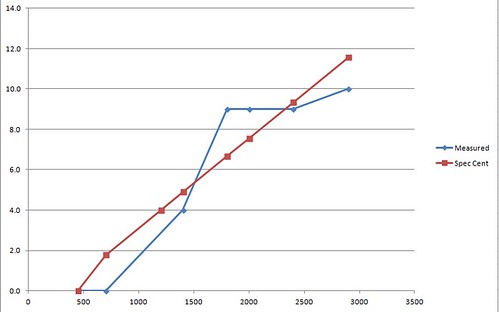With that roadblock firmly in my way, I chose another path and grabbed work light, dwell meter, timing light, notepad, and pen and headed out to the curb where Glinda sat. In response to yesterday’s blog post, I received a comment that I should check the centrifugal advance of Glinda’s distributor since a lack of advance at higher rpms would be detrimental to her fuel mileage. I hooked up the timing light, disconnected and plugged the vacuum advance hose, and fired up the engine. With the light aimed at the timing marks, I revved the engine and watched with a little sadness as the timing climbed with the rpms. Okay, it’s moving, but is it moving enough? I hooked up the dwell meter and flipped its switch to tachometer mode. After begging Mikhaila to come out and “drive” the car for me, I had her press and hold the gas pedal at different engine speeds while I measured the timing. The following graph shows the different advances I measured plotted against the spec’s straight line values.

The differences are probably just due to not being able to hold the rpms perfectly steady. Regardless, the centrifugal advance weights seem to be doing their job inside the distributor.
On to vacuum advance. The spec says I should be seeing 24 degrees of advance when the carburetor port is sucking air at a level of fifteen inches of mercury. I hooked up my vacuum gauge and determined Glinda’s engine hits this mark at around 2000 rpm. With the vacuum advance tube reconnected to the advance on the distributor, I turned the engine back on and noted the advance due to vacuum was about 8 degrees. When I revved the engine up to the aforementioned 2000 rpm, it jumped up to 17. Bear in mind, gentle reader, that part of this jump was due to centrifugal advance. If I back out the centrifugal advance at 2000 rpm, I end up with only 10 degrees instead of the required 24.
Thinking this was an aha moment, I awoke this morning with hopefully simple task of swapping out Glinda’s current vacuum advance with one from a distributor on the shelf. I did that, but it doesn’t look like it’s made much difference. Only time (and miles) will tell. One other thing I’ll check (thanks to a Facebook post from a ‘vair guy) are a plug from each bank. If one is sooty, then that carb is running rich and I’ll swap it out for the one good rebuilt carb from TwoTone.

No comments:
Post a Comment